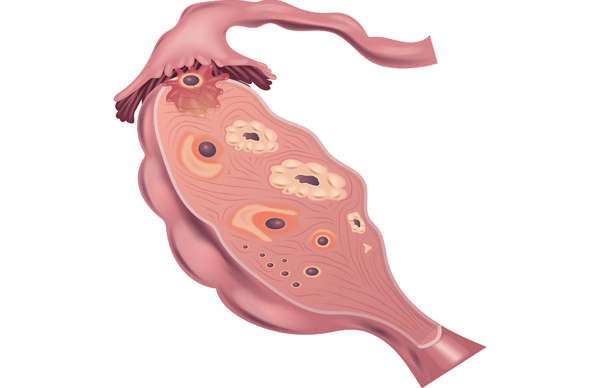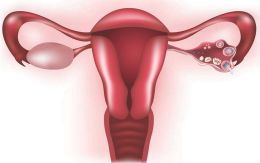
There are several types of Ovarian Cysts
 Ovarian Cysts are a common occurrence among women of reproductive age. There are several types of Ovarian Cysts – some are no cause for concern, while others create ovary pain and require treatment. Ironically, women with PCOS (Polycystic Ovarian Syndrome), or PCOD (Polycystic Ovarian Disorder), might not have the characteristic Polycystic Ovaries for which this disorder is named. At other times, they might have other kinds of Ovarian Cysts. The best Ovarian Cyst Treatment is actually prevention. Taking good care of your health by eating a nutritious diet, exercising regularly, and taking healthful nutritional supplements is the first line strategy for PCOS and its troubling symptoms.
Ovarian Cysts are a common occurrence among women of reproductive age. There are several types of Ovarian Cysts – some are no cause for concern, while others create ovary pain and require treatment. Ironically, women with PCOS (Polycystic Ovarian Syndrome), or PCOD (Polycystic Ovarian Disorder), might not have the characteristic Polycystic Ovaries for which this disorder is named. At other times, they might have other kinds of Ovarian Cysts. The best Ovarian Cyst Treatment is actually prevention. Taking good care of your health by eating a nutritious diet, exercising regularly, and taking healthful nutritional supplements is the first line strategy for PCOS and its troubling symptoms.
Health Risks
PCOS and Ovarian Cysts Risks?
 Has your doctor told you, “I have your results here: Cysts on Ovary”? If so, it’s important to realize that women with Polycystic Ovarian Syndrome (PCOS) have cysts that pose different levels of concern since Ovarian Cysts fall into various categories. In the United States, Ovarian Cysts of some type are prevalent in nearly all pre-menopausal women and 14.8 percent of post-menopausal women.1
Has your doctor told you, “I have your results here: Cysts on Ovary”? If so, it’s important to realize that women with Polycystic Ovarian Syndrome (PCOS) have cysts that pose different levels of concern since Ovarian Cysts fall into various categories. In the United States, Ovarian Cysts of some type are prevalent in nearly all pre-menopausal women and 14.8 percent of post-menopausal women.1
These cysts are fluid-filled sacs located within or on the outside wall of the ovary. The majority of Ovarian Cysts are benign; they cannot be prevented and frequently will go away without treatment. Some cysts grow painfully large and must be removed. Studies have also shown that women who are past menopause and who have Ovarian Cysts have a higher risk of ovarian cancer.2
Symptoms
Ovarian Cyst Symptoms Range Widely in Makeup and Degree of Seriousness
 Ovarian cyst symptoms range widely in makeup and degree of seriousness. Some women with Ovarian Cysts do not experience any symptoms. Others suffer from abdominal pain, weight gain, pain during sexual intercourse, breast tenderness, painful menstrual periods, abnormal bleeding, and/or nausea or vomiting. Cysts may bleed, rupture, or twist the ovary, causing significant pain.3 Symptoms a woman experiences can vary in accordance with the type of cyst she has. Types of Ovarian Cysts include:
Ovarian cyst symptoms range widely in makeup and degree of seriousness. Some women with Ovarian Cysts do not experience any symptoms. Others suffer from abdominal pain, weight gain, pain during sexual intercourse, breast tenderness, painful menstrual periods, abnormal bleeding, and/or nausea or vomiting. Cysts may bleed, rupture, or twist the ovary, causing significant pain.3 Symptoms a woman experiences can vary in accordance with the type of cyst she has. Types of Ovarian Cysts include:
- Functional
- Endometriomas
- Cystadenomas
- Dermoid Cysts
- Polycystic Ovaries
Functional Cysts
The most common Ovarian Cysts are functional cysts, which form during a woman’s normal menstrual cycle.6 Each month, the ovary grows tiny sacs that hold the eggs. After a sac breaks open and releases the egg, the sac normally dissolves. On some occasions, however, the sac doesn’t break open, but continues to grow, or it might release the egg and then fail to dissolve. The resulting growth is a functional cyst. These cysts usually disappear naturally within a few weeks or months. Functional cysts are almost never associated with cancer.4
Endometriomas, Cystadenomas, and Dermoid Cysts
Some women experience other, more serious Ovarian Cysts, when they have Polycystic Ovarian Syndrome, such as endometriomas, cystadenomas, and dermoid cysts. Endometriomas develop in women who have endometriosis whereby tissue from the lining of the uterus attaches to an ovary and forms a growth. Other cysts include cystadenomas and dermoid cysts, which develop from cells in the ovary. Cystadenomas are filled with a liquid or a sticky fluid. Dermoid cysts can contain hair, bone, teeth, and cartilage. All of these cysts can become large and painful and usually require removal.5
Polycystic Ovaries
Women who suffer from Polycystic Ovarian Syndrome have multiple small cysts located on their ovaries. In a picture of a polycystic ovary, the ovary is larger than normal, with cysts resembling a string of pearls located around the edge. Fertility with Polycystic Ovarian Syndrome is often an issue; sufferers frequently experience difficulty with conception. An causative factor of PCOS is Insulin Resistance, a condition that occurs as a result of the inability of the body’s cells to properly utilize insulin. When Insulin Resistance occurs, your body’s cells begin to be impervious to insulin, which is supposed to allow glucose, blood sugar, to enter and convert into energy. The imbalance of this extra insulin can cause imbalances in other hormones, like androgens (male sex hormones), making levels that are disproportionately high. When this occurs regular functions cease and excess levels of testosterone bring about Polycystic Ovarian Syndrome and other physical changes that are painful, like ovarian cysts.
Detection of Ovarian Cysts
Most women with Ovarian Cysts don’t exhibit symptoms. It’s not until a cyst causes pain in the belly or pelvis that it’s noticed. The pain is often caused any of the following reasons:
- Quick growth and stretching
- Bursting of the cyst
- Bleeding into the cyst
- Torsion (a twisting of the cyst around its blood supply)
If the cyst has reached a large size, then you might have other symptoms arise as a result of pressure or distortion in your pelvis. These symptoms can include conditions like abdominal fullness or bloating, indigestion, feeling full after eating only a small amount, feeling an urge to defecate or having difficult bowel movements, or painful sexual intercourse.7
Your physician can detect the presence of cysts through a routine pelvic exam or an ultrasound, and verify it with a check of hormone levels. If a physician believes more information is needed, in addition to an ultrasound, cysts can also be detected with other imaging methods like a CT scan or MRI scan (magnetic resonance imaging).7
Natural Therapies
Prevention of Ovarian Cysts
 Although it is not possible to totally prevent Ovarian Cysts, you can take certain steps to improve your overall health that can be helpful in reducing the occurrence of Ovarian Cysts. These steps include improving your overall diet, increasing your exercise, reducing your stress levels, and balancing your hormonal systems. These are important steps in the treatment of PCOS and Insulin Resistance, as well as in reducing the risk of Ovarian Cysts.
Although it is not possible to totally prevent Ovarian Cysts, you can take certain steps to improve your overall health that can be helpful in reducing the occurrence of Ovarian Cysts. These steps include improving your overall diet, increasing your exercise, reducing your stress levels, and balancing your hormonal systems. These are important steps in the treatment of PCOS and Insulin Resistance, as well as in reducing the risk of Ovarian Cysts.
Because there is no single solution that addresses all the symptoms of PCOS or Insulin Resistance, you must rely on a multi-faceted approach to dealing with these conditions. A complete system, including nutritional supplements (vitamins, minerals, and botanicals that are condition specific), a realistic exercise program, nutritional guidance, a support network that will help you change unhealthy lifestyle choices, and access to information like that found on this website is required to address the issues presented by these syndromes.
Polycystic Ovaries can be caused by Insulin Resistance-related obesity, which the Insulite PCOS System has been scientifically designed to reverse by balancing glucose, insulin, and hormone levels, in combination with a nutritious diet and regular exercise. One ingredient is magnesium, which helps maintain normal blood glucose levels as well normal insulin secretion-major factors in cyst formation.
If you’d like to learn more about PCOS, ovarian cysts, Insulin Resistance, or the Insulite PCOS System, be sure to explore the Insulite Health website. You’ll find a wealth of information and our experts are ready to provide you with guidance regarding your concerns at no cost and no obligation-so contact us today.
Treatment Options
Treatment of Ovarian Cysts
 A physician can choose one of three tactics to treat Ovarian Cysts. Initially, the physician might choose to watch and wait, which can involve evaluating blood tests such as a CA-125 to help determine the potential for cancer. The cyst might go away on its own, which is the case with most functional cysts. If the cyst is fairly large, the doctor might choose to prescribe birth control pills, in order to alter the hormone levels, which can cause the cyst to shrink and disappear. The final alternative for treatment is surgical removal of the cyst. Cysts can be surgically removed either with laparoscopy, or if needed, an open laparotomy (using an incision at the bikini line) if they are causing severe pain or they are suspicious in nature. Once the cyst is removed, the growth will be sent to a pathologist to examine the tissue under a microscope to make the final diagnosis regarding the type of cyst removed.
A physician can choose one of three tactics to treat Ovarian Cysts. Initially, the physician might choose to watch and wait, which can involve evaluating blood tests such as a CA-125 to help determine the potential for cancer. The cyst might go away on its own, which is the case with most functional cysts. If the cyst is fairly large, the doctor might choose to prescribe birth control pills, in order to alter the hormone levels, which can cause the cyst to shrink and disappear. The final alternative for treatment is surgical removal of the cyst. Cysts can be surgically removed either with laparoscopy, or if needed, an open laparotomy (using an incision at the bikini line) if they are causing severe pain or they are suspicious in nature. Once the cyst is removed, the growth will be sent to a pathologist to examine the tissue under a microscope to make the final diagnosis regarding the type of cyst removed.
Next Steps
- Take the PCOS Quiz! Get your score and assess your hormone health risks.
- Join our Facebook Sisterhood Group Pose your questions to this group of like-minded women. Get the answers to your questions and the support you need.
- Checkout the Hormone Reset. Guided Practices to eliminate anxiety, lose weight and boost energy.
We are committed to helping women reverse their symptoms of hormone imbalance – a major cause of excess weight gain, adult acne, unwanted facial hair, depression, anxiety, and heartbreaking female infertility.
©Insulite Health empowers women with hormone imbalance to transform their lives through a process of healing with the Natural Hormone Solution –a complete solution for helping women reverse the symptoms hormone imbalance..
